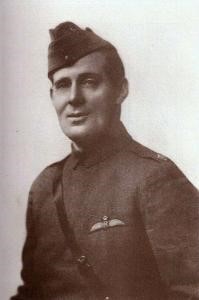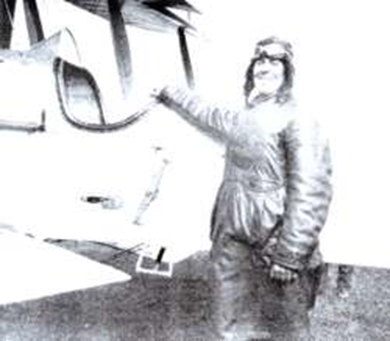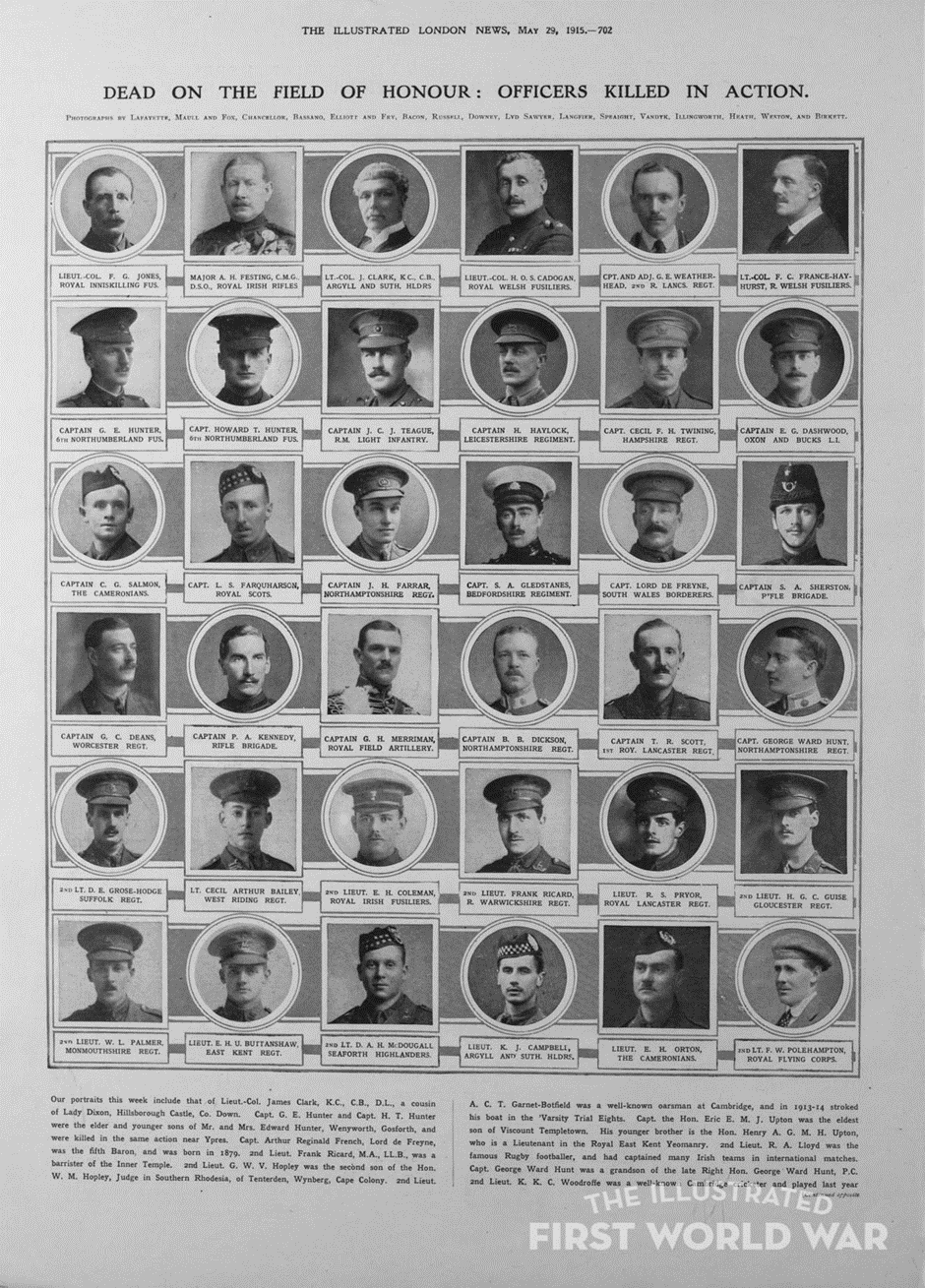FREDERICK WILLIAM POLEHAMPTON
Lieutenant, No.8 Squadron, Royal Flying Corps
Killed in Action, 26 April 1915, near Ypres, Belgium, aged 41.
Buried in Longuenesse (Saint-Omer) Souvenir Cemetery, Pas de Calais, France: Grave I. A. 89

Frederick William Polehampton
Lieutenant Frederick William Polehampton, No.8 Squadron, Royal Flying Corps, was born in Hartfield on 14 June 1873. He lived at The Rectory, Hartfield and was the son of the Reverend Edward Polehampton and his wife Helena (née Reilly).
Personal and family background
Frederick came from a distinctly upper-class family. His grandfather, Edward Polehampton M.A., was an Eton College scholar and Fellow of King's College, Cambridge. He became Rector of Great Greenford, Middlesex and married Elizabeth Stedman daughter of Thomas Stedman, Vicar of St. Chad's, Shrewsbury. Of their nine children five of their sons also entered the ministry, although Frederick's uncle, Henry Stedman Polehampton, resigned the position of Rector of St. Algates, Oxford, after six months because it was not compatible with his Fellowship of Pembroke College, Oxford. He subsequently volunteered for the Chaplaincy of the Residency of Lucknow, India, where he died from cholera after being wounded at the Siege of Lucknow during the Indian Rebellion of 1857.
Frederick's father, Edward Thomas William Polehampton, also attended Eton College and graduated with an M.A.from Pembroke College, Oxford. In 1859 he became Rector at Hartfield. Ten years later he married Helena Cecilia Reilly and they had five children of which Frederick was the second of three sons. Born on 14 June 1873 he was baptised on 6 July in his father's church, St. Mary's, Hartfield.
According to the 1881 census Frederick had one sister and two brothers, and they were all under the tutelage of a German governess. In September 1886 Frederick enrolled as a student at St. Nicholas College, Lancing, Sussex, described at the time as 'a Christian Foundation in the Anglican Tradition' and as 'a training school for the Universities'. He was a member of School House from September 1886 to July 1891. That month, his education at Lancing complete, he left the college with no sign of him following the family traditions of University or the Church. Frederick thereafter presented himself as 'a gentleman of independent means'. The only record so far found indicating otherwise refers to him as an 'English Merchant' when returning to Liverpool from New York on board the R.M.S Campania in September 1897.
On 9 October 1899, at Christ Church Cathedral, Victoria, British Columbia, he married Kate Eunice Polehampton (née Davie) (1878-1963) of Victoria, later of 10 Dorset Square, Marylebone in London. They returned to the UK from New York on the SS Oceanic landing at Liverpool on 20 November 1901. They do not appear to have had any children.
On their arrival from Canada the couple took up residence at Heyford Grange, Nether Heyford, Northamptonshire. By 1902 they had relocated to a property called 'The Comedy' in Christian Malford, Chippenham, Wiltshire, now a Grade II listed building, where Frederick became the honorary secretary of the North Wiltshire polo club. He participated in the annual club gymkhana of that year winning both 'the pig sticking' competition and 'tandem' events on a horse named 'Comedy'.
In 1906 Frederick took the lease of a property, 'The Manor House' at Burton Dassett, Warwickshire, owned by Richard Greville Verney, the 19th Baron Willoughby de Broke, the master of the Warwickshire Hunt. Frederick subsequently joined the hunt and was regarded by his peers as 'a cheery soul who will jump at anything that comes in the line'. He also became a member of the Moreton Morrell polo club.
He had many sporting interests. He competed in twelve hour cycling races at Herne Hill Velodrome for Anerley and London Cycling Club and played football for teams in both Sussex and Surrey with reports indicating that he was a 'hard tackling defender'. By 1896 he owned a string of race horses, among them 'Miss Clifden II', who ran in the Grand National of 1902 ridden by Mr H M Ripley, although it was considered an "also ran".
Frederick's interest in speed seems to have been reflected in his interest in driving motor cars fast. On Monday the 18 September 1910 he was summoned to appear at the Warwick police Court for driving a motor car along Longbridge Road in Warwick in a manner dangerous to the public. Reports estimated that he was driving at 50-60 miles per hour in a vehicle described as an engine with two seats. The vehicle braked and then spun three times with Frederick being thrown out. He insisted that this was caused by him trying to avoid a dog in the road. Angry witnesses to the speeding became more conciliatory when they learned about the survival of the dog. Frederick was nevertheless fined £10. During the trial it transpired that he had previous convictions between 1905 and 1909 for similar offences. He had then been found guilty and fined with what appears to be the statutory £10 and in addition, on one occasion, to further sum of ten shillings and sixpence for his failure to produce his licence.
Frederick had various pre-war occupations. For a time he was in partnership with John Lindsay Scott in the motor car dealership of Scott and Polehampton at 161 Piccadilly, London (now Caviar House and Prunier), but the business was wound up on 31 August 1912.
The lease on the Burton Dassett property although for 21 years was reviewable 7 years into the term. It could be assumed therefore that it was at this point, around 1912, that the Polehamptons transferred their residence to Walton Wood House on the outskirts of the Walton Hall Estate near Stratford-upon-Avon, Warwickshire. In May of that year he was elected as a vice president of nearby Kineton Working Men's Constitutional Club.
Military service
Just after the outbreak of war Frederick Polehampton was given the temporary rank of 2nd Lieutenant in the 15th Hussars, part of the 14th Cavalry Reserve. Having taken flying lessons in a Grahame-White Biplane at Grahame-White School, Hendon, he received his Aviators' Certificate No.914 on 27 September 1914 from the Royal Aero Club. He was confirmed in the rank of 2nd Lieutenant, appointed as a Flying Officer, and seconded to the Royal Flying Corps on 1 January 1915. He was posted to No.8 Squadron, which was formed at Brooklands, Surrey, on 1 April. He was promoted to Lieutenant on 24 April 1915, two days before he was killed.

Frederick Polehampton — 'Ready for Flight'
(Click to enlarge)
No.8 Squadron was the first squadron to be fully equipped with the BE2c biplane, a new aircraft considered particularly suited to reconnaissance flights because of its inherent stability. The first were allocated towards the end of January 1915. On reaching its establishment of twelve aircraft the squadron was ordered overseas to bring the wings abroad up to a strength of three squadrons each. On 15 April 1915 eight machines arrived safely at Saint-Omer, Pas de Calais. Of the remaining four, one was wrecked at Gosport, two crashed at Folkestone, and one, which developed engine trouble, came down at Dover for repairs. Transport and personnel left a few days later. By 25 April the whole squadron was fully assembled at Saint-Omer, and came under the orders of the Officer Commanding (OC), 3rd Wing, the following day.
No.8 Squadron was engaged in the perilous work of strategic reconnaissance and special GHQ missions. There were casualties in an early raid with 20 pound bombs, aimed at disrupting rail communications between Ghent and the Ypres salient. Some of the planes, says the official history, "either lost their way or else their bombs failed to leave the improvised racks". Within a fortnight of arrival in France, the six remaining BE2c biplanes were transferred to Abeele to make up the strength of the 2nd Wing, with 5 and 6 squadrons.
The day after No.8 squadron arrived in France, Frederick Polehampton was killed in an accident at Saint-Omer while flying a BE2c (registration 1758). He was the squadron's first casualty. No.8 squadron continued to serve on the Western Front throughout the remainder of the Great War.

No. 8 Squadron Arrives. A BE2c crash-lands
en route to Saint-Omer, northern France, April 1915(Source: Squadron archive)
(Click to enlarge)
Frederick Polehampton was aged 41 when he was killed. He is buried in Longuenesse (Saint-Omer) Souvenir Cemetery: Grave I.A.89, and is commemorated on the war memorials at Hartfield and in the Warwickshire hamlet of Walton D'Eivile. His name also appears on the Roll of Honour located in the Walton Church of St.James. He was also commemorated along with other officers killed in action in an edition of the Illustrated London News dated 29 May 1915 (below).

Dead on the Field of Honour: Officers Killed in Action
(Frederick Polehampton is in the bottom right-hand corner)
(Click to enlarge)
(Source: Illustrated London News, 29 May 1915)
On 22 September 1915 an auction of furniture etc. was held by Locke & Son at Walton Wood House announcing that Frederick's widow Kate would be leaving the district. Following her husband's death she remained in England. Apart from visits, on a number of occasions to her sister in Phoenix, Arizona she moved between various fashionable addresses in London and some of her summers were spent at a property in Fortfield Terrace in Sidmouth, Devon. She died in the town's cottage hospital on 23 November 1963.
Carol O'Driscoll
31 August 2015
Updated 7 October 2019
Acknowledgements Frederick William Polehampton by Grev Hudson, Dene Valley U3A, 2016

